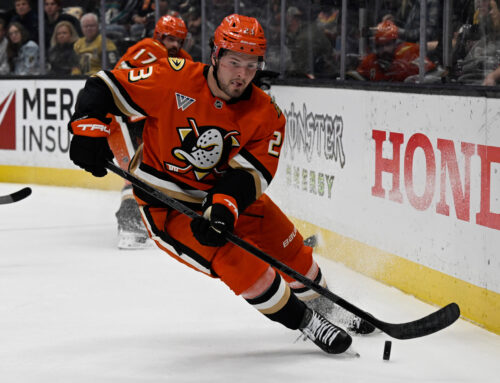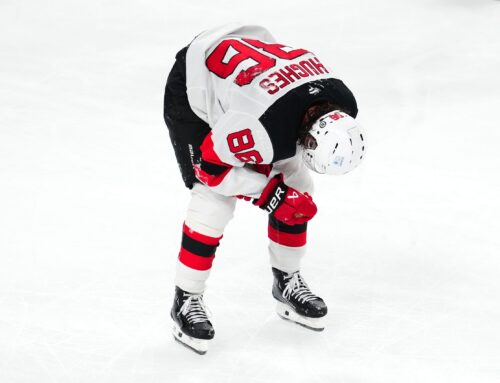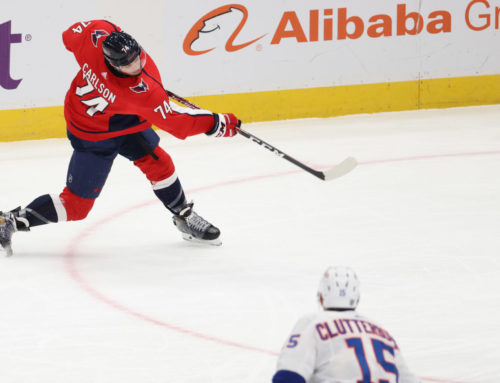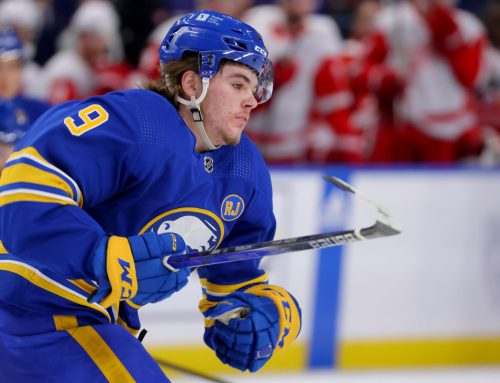Team Canada, currently in the World Junior bubble in Red Deer, Alberta, will all quarantine for 14 days following two positive tests on the roster. Those positive tests came after another positive test elsewhere in the organization a few days earlier. We will post more once more is known but that’s all we have for now.
*
A Happy Thanksgiving to our American neighbours to the south. It has been a tough year for a lot of people so maybe the list of reasons to give thanks is a bit shorter tonight than in most years, and that is lamentable. But there has been some good news with regards to vaccines and distribution schedules so there are lights at the end of the tunnel. We just need patience.
*
Johnny Boychuk has retired due to the eye injury suffered last year. It is a sad way for a such a solid career to finish, but health is paramount and hopefully he can now enjoy more time with his family. Boychuk retires with just 206 career points but that doesn’t speak to his stalwart defensive abilities. He will be best remembered as an integral part of the 2011 Bruins roster that won the Stanley Cup. All the best to him and his family in the future.
*
An update from Pierre LeBrun on the efforts between the NHL and NHLPA for getting next season underway:
Hearing that NHLPA executive director Donald Fehr and NHL commissioner Gary Bettman haven’t spoken since last Thursday. Which speaks to how the players feel regarding the NHL’s salary deferral/escrow asks. Still time to salvage this, however. I think next week is important.
— Pierre LeBrun (@PierreVLeBrun) November 25, 2020
We will be going into December without a deal and that starts to put a lot of strain on a January 1st start. It was suggested by Larry Brooks that we're going to a 48-game season starting towards the end of January and that makes sense. It allows players to get through the holidays with their families while allowing the NHL to stay on a relatively normal schedule for 2021-22 (with, hopefully, some fans).
*
LeBrun also wrote an article on Tuesday outlining some of the playoff scenarios the NHL is contemplating. One of the leading ideas is to have divisions play within themselves for the playoffs, meaning the first two rounds would be in a divisional 'bubble'. That, in turn, means we're guaranteed two Canadian teams in the second round of the playoffs, and at least one in a Conference Final. The final four teams would effectively be divisional winners.
The idea here is to cut down on travel and also skirt some of the border requirements between Canada and America. It is probably an unfair way to go about things, but it seems the owners are more concerned with a normal 2021-22 season than this coming season.
*
Cam had an update on Cole Caufield in his Ramblings yesterday and the good news was all the defensive ability he has been showing. I don't think anyone is too concerned with his ability to score; it was just his ability to do everything else. If he can keep up his two-way play, I think he pushes for a roster spot in 2021-22. They have Tomas Tatar's and Joel Armia's contracts running out so there is room in the top-9, they just need to slide someone (probably Tyler Toffoli) to the left wing.
*
I had a little bit here about the Bolts’ cap situation but Mikhail Sergachev threw a wrench in that and signed for three years with an AAV of $4.8M. This means each of McDonagh, Hedman, and Sergachev will be around for at least three years, barring a trade. If they can get Cernak under contract, that’s a very good top-4 for the near future.
But that’s the crux here. The Lightning are now $3M over the cap with both Cirelli and Cernak left to sign. If they want to sign them both, they have to trade two of Killorn, Johnson, Palat, or Gourde, and each has some form of trade protection. With a flat cap, trading one will be hard enough. Trading two just adds more problems. I think we see something like a Johnson+Cernak or Gourde+Cernak package going somewhere like New Jersey or Detroit, which kind of gets two birds stoned at once: they free up enough space to sign Cirelli to a bridge (or get close enough to it that they can trade someone cheap and without trade protection like Coleman or Paquette) while not need to deal with Cernak’s contract. Whatever ends up happening, there are still a few significant moves coming from Tampa before the season begins.
*
Last week I took a couple Ramblings to explain some league-wide trends. The first Ramblings talked more about the league in general, which included rising goal/shot/assist rates, declining hit rates, and a status-quo shot-blocking rate. The next one was more about changing trends among forwards and defencemen, looking at things like goal and shot rates, as well as shooting percentage changes. Going back through those Ramblings will get readers caught up on what we've got going on here, as well as prevent me from having to re-explain all the conditions again.
We're going to move along today and look at changes in peripheral categories like hits, blocks, and penalty minutes among forwards and defencemen. Remember, this is at all strengths and we're using two three-year segments. Let us start with the forwards. Data from Natural Stat Trick.
| 2014-17 | 2017-20 | |
| Blocks/60 | 1.88 | 1.91 |
| Hits/60 | 5.02 | 4.57 |
| PIM/60 | 2.02 | 1.72 |
As shot rates across the league have risen, shot-blocking rates among forwards has risen as well, though not by a significant margin. That difference of 0.03 blocks/60 minutes amounts to three-quarters of one blocked shot in a 1500-minute season. Maybe 7-8 blocked shots for an entire fantasy roster. That really doesn't change much for us.
It is the next two categories that are of interest. Hit rates have declined by about nine percent over our two samples while PIM rates went down roughly 15 percent. In a season of 1500 all-strengths minutes, an average forward would produce 11-12 fewer hits compared to a few years ago. When looking at penalty minutes, that difference is about 7-8 minutes. When considering a fantasy roster with nine starting forwards, we're talking target changes of about 110 hits over the course of a season, and around 70 penalty minutes. This isn't like in MLB when everyone started striking out every fourth plate appearance and thus drastically altered everything about the fantasy game, but it is a change for us, and one we need to account for.
The changes, in real terms, look like this: the average forward, over 1500 minutes in 2014-17, would land about 125 hits. That has fallen to around 114-115. For penalty minutes, that means needing about 50 PIMs per forward to about 43. That means fantasy rosters (again, assuming nine forward starters) need about 100 fewer hits and about 70 fewer penalty minutes.
(I want to note that 1500 minutes is a lot for a forward in an 82-game season. In 2018-19, fewer than 10 percent of forwards reached that mark. I used it because it gives us a whole number when divided by 60. Round numbers are nice.)
Let's get to the blue liners.
| 2014-17 | 2017-20 | |
| Blocks/60 | 4.45 | 4.37 |
| Hits/60 | 4.24 | 4.19 |
| PIM/60 | 1.65 | 1.53 |
Down, across the board. Now, most of the declines are insignificant, and the largest decline was in PIMs, and that was less than five percent. But it is worth noting that as shot blocking has risen among forwards in conjunction with rising shot rates across the league, it's declining for defencemen. Why?
My off-the-cuff theory kind of ties into what was explained in the trends pieces last week: teams are being more selective on where they shoot from. That means passing up shots when lanes are clogged, where five years ago, we'd just get a hammer shot into some shinpads. Do not forget that with the rising shot rates, we've also seen a rise in shot attempts turning into shots on goal, which in itself leads to fewer shot-blocking attempts. So, even with more shots, defencemen are blocking less. Not by a lot, but it's worth noting that this trend is not rising.
The hits did not decline nearly as much as forwards and that makes some intuitive sense when thinking about their positions. I have spent a good portion of the last five years talking about how the game is changing, namely defencemen being more involved in the play. With defencemen presumably jumping into the play more, I thought we might see a status quo on hits, if not a small rise. That is why it's important to check assumptions and not just assume things are the way we think they are. (Also, it's possible there isn't a larger decline because defencemen are jumping into the play more, but I have no idea how to tease that data out, or if it's even possible.)
Declining PIMs matches trends around the league, though it's not nearly as steep as forwards. With four starting d-men on a roster, we're talking maybe 8-9 penalty minutes over the course of the entire season.
So, we learned forwards are blocking more shots, but not by much, and are hitting and taking penalties at a much lower rate than a few years ago. Conversely, defencemen are blocking fewer shots and hitting less, just not by much. The decline in blocks is interesting considering the rise in shot rates across the league, so there may be more to study here. PIMs declined by the largest amount, but it's not hugely significant for us.
This is the point where I remind readers that our Dobber Hockey guide has a section on multi-cat performers, as well as projections for top performers in categories like blocks and hits.





 MTL
MTL
 PIT
PIT FLA
FLA S.J
S.J CGY
CGY MIN
MIN OTT
OTT
